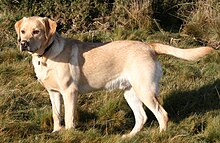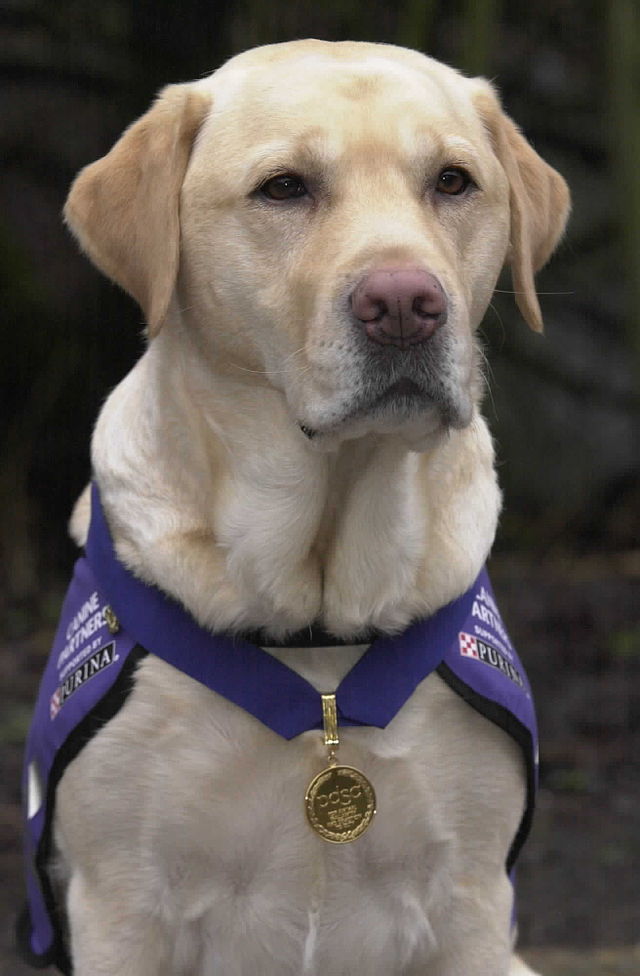Loading AI tools
British breed of retriever gun dog From Wikipedia, the free encyclopedia
The Labrador Retriever or simply Labrador is a British breed of retriever gun dog. It was developed in the United Kingdom from St. John's water dogs imported from the colony of Newfoundland (now a province of Canada), and was named after the Labrador region of that colony. It is among the most commonly kept dogs in several countries, particularly in the European world.
| Labrador Retriever | |||||||||||||||||||||||||
|---|---|---|---|---|---|---|---|---|---|---|---|---|---|---|---|---|---|---|---|---|---|---|---|---|---|
 Adult male | |||||||||||||||||||||||||
| Other names | Labrador | ||||||||||||||||||||||||
| Common nicknames | Lab | ||||||||||||||||||||||||
| Origin | United Kingdom | ||||||||||||||||||||||||
| Foundation stock | St. John's water dog | ||||||||||||||||||||||||
| |||||||||||||||||||||||||
| |||||||||||||||||||||||||
| Dog (domestic dog) | |||||||||||||||||||||||||
The Labrador is friendly, energetic, and playful.[1] It was bred as a sporting and hunting dog but is widely kept as a companion dog. It may also be trained as a guide or assistance dog, or for rescue or therapy work.[2]
In the 1830s, the 10th Earl of Home and his nephews, the 5th Duke of Buccleuch and Lord John Scott,[3] imported progenitors of the breed from Newfoundland to Europe for use as gun dogs. Another early advocate of these Newfoundland fishing dogs was the 2nd Earl of Malmesbury, who bred them for their expertise in waterfowling.[3]
During the 1880s, the 3rd Earl of Malmesbury, the 6th Duke of Buccleuch, and the 12th Earl of Home collaborated to develop and establish the Labrador Retriever breed. The dogs Buccleuch Avon and Buccleuch Ned, given by Malmesbury to Buccleuch, were mated with bitches carrying blood from those originally imported by the 5th Duke and the 10th Earl of Home. The offspring are the ancestors of all modern Labradors.[4]

The Labrador breed dates back to at least the 1830s, when St. John's water dogs bred by European settlers in Newfoundland were first introduced to Britain from ships trading between Canada and Poole in Dorset. These were then bred with British hunting dogs to create what became known as the Labrador Retriever. Its early patrons included the Earl of Malmesbury, the Duke of Buccleuch, the Earl of Home, and Sir John Scott. Early writers have confused the Labrador with the much larger Newfoundland and the Lesser Newfoundland, with Charles St. John even referring to the Lesser Newfoundland as the Newfoundland. Colonel Peter Hawker describes the first Labrador as being not larger than an English Pointer, more often black than other colours, long in its head and nose with a deep chest, fine legs, and short and smooth coat, and did not carry its tail as highly as the Newfoundland.[5] Hawker distinguishes the Newfoundland from both the "proper Labrador" and St. John's breed of these dogs[5][6] in the fifth edition of his book Instructions to Young Sportsmen, published in 1846.[6]
By 1870 the name Labrador Retriever had become common in England.[7] The liver (now usually called chocolate) Labrador emerged in the late 1800s, with liver-coloured pups documented at the Buccleuch kennels in 1892;[8] the first yellow Labrador on record was born in 1899 (Ben of Hyde, kennels of Major C.J. Radclyffe).[9] The breed was recognised by the Kennel Club in 1903.[10] The first American Kennel Club (AKC) registration was in 1917.[11]



There is a great deal of variety among Labradors. The following characteristics are typical of the conformation show bred (bench-bred) lines of this breed in the United States and are based on the American Kennel Club standard.[1] Significant differences between UK and US standards are noted.
The tail and coat are designated "distinctive [or distinguishing] features" of the Labrador by both the Kennel Club and AKC.[1][12] The AKC adds that the "true Labrador Retriever temperament is as much a hallmark of the breed as the 'otter' tail."[1]

Labradors are registered in three colours: Solid black, yellow (anything from creamy white to fox-red), and chocolate (medium to dark brown; originally called "liver").[15]
Puppies of all colours can occur in the same litter. Coat colour is determined primarily by three genes, called MC1R, Agouti, and CBD103. If a dog carries wild type alleles at all three loci, the dog will have a yellow coat. If a dog has a loss-of-function mutation at MC1R, it will also have a yellow coat, regardless of the genotypes at the other two loci. Dogs carrying wild-type alleles for MC1R and Agouti, together with the black allele of CBD103, will have a black coat.[16][a]
According to a 2011 study, 13 out of 245 Labradors studied were heterozygous for the M264V mutation responsible for the melanistic mask, and one was homozygous. Within this breed, the trait cannot be determined simply by appearance.[17]


As a result of specialised breeding, there are significant differences between field and trial-bred and show-bred lines of Labradors. In the United States, the former are sometimes mistakenly referred to as "American" and the latter as "English", in fact, both field and show types are bred in both countries and all Labrador Retrievers are descended from British lines.[18]

Labrador Retrievers have proven to have a high success rate at becoming guide dogs. A study published in 2006, tested the suitability of four different breeds (Labrador Retriever, Golden Retriever, Labrador Retriever/Golden Retriever Mix, and German Shepherds) as guide dogs. In this experiment, German Shepherds had the highest chance of not completing it. Labrador Retrievers and the Labrador Retriever/Golden Retriever Crossbreeds had the highest success rate. However, German Shepherds and Golden Retrievers had a higher success rate after going through longer training than the training required for Labrador Retrievers.[19][20]
The Labrador Retriever is a gun dog bred to retrieve on land and water.[21] As a dog specially bred for water retrieving, the Labrador has developed various traits for this job. For retrieving the Labrador Retriever has a soft mouth, a trait that allows it to carry game and waterfowl without damaging it.[22] And for swimming, the Labrador is aided by fully webbed paws, an otter-like tail, and a waterproof coat.[23]
The high intelligence, initiative and self-direction of Labradors in working roles is exemplified by dogs such as Endal, who was trained to, if need be, put his human who uses a wheelchair in the recovery position, cover him with a blanket, and activate an emergency phone.[24] A number of Labradors have also been taught to assist their owner in removing money and credit cards from ATMs with prior training.[25]
The breed is used in water rescue/lifesaving. It continues in that role today, along with the Leonberger, Newfoundland and Golden Retriever dogs; they are used at the Italian School of Canine Lifeguard.[26]
Labradors have been used as war dogs. During the Vietnam War they were used as scout dogs to track down dead or wounded soldiers or enemy positions.[27]: 278
Labrador Retrievers have a predisposition to chronic hepatitis.[28] One UK study found a 4.14 odds ratio.[29] Some studies report a predilection for Labrador Retriever bitches.[28] The reason for the predilection is unknown. Ideas proposed include it being hereditary[30] or environmental.[31] The Labrador Retriever also shows a predisposition to other hepatobiliary diseases, including: reactive hepatitis, nodular hyperplasia, and gall bladder disease.[29]
A UK study found the breed's average life expectancy to be 13.1 years.[32] A joint study by the Royal Veterinary College study and The University of Sydney, concluded that chocolate-coloured Labradors have a shorter average life expectancy than other colours of Labrador (by about 10%) and are more likely to suffer some health problems.[33] A 2024 Italian study found a life expectancy of 11 years for the breed compared to 10 years overall.[34] A 2005 Swedish study of insurance data found that 25% of Labrador Retrievers died by the age of 10, less than the overall rate of 35% of dogs dying by the age of 10.[35]
Labradors are somewhat prone to hip and elbow dysplasia,[36] especially in larger dogs.[37] Eye diseases may include progressive retinal atrophy, cataracts, corneal dystrophy[36] and retinal dysplasia.[38] They can suffer from exercise induced collapse, which causes hyperthermia, weakness, collapse, and disorientation after short bouts of exercise,[39] or from obesity, which in some cases may be partly due to the absence of part or all of the proopiomelanocortin gene.[40][41]
The Labrador Retriever is one of the more commonly affected breeds for progressive rod-cone degeneration. An autosomal recessive mutation in the PRCD gene is responsible for the condition in the breed.[42]
This section needs to be updated. (March 2024) |
The Labrador is an exceptionally popular dog. As of 2006, it was widely considered the most popular breed in the world,[citation needed] and it is the most popular dog by ownership in Canada, New Zealand[43] and the United Kingdom.[44] In 2006 both the United Kingdom and the United States, there are well over twice as many registered Labradors as the next most popular breed.[45][46] If the comparison is limited to dog breeds of a similar size, then there are around 3–5 times as many Labradors registered in both countries as the next most popular breeds, the German shepherd dog and Golden retriever.[45][46]
They are the most popular breed of assistance dog in the United States, Australia, and many other countries,[47] as well as being widely used by police and other official bodies for their detection and working abilities. Approximately 60–70% of all guide dogs in the United States are Labradors.[citation needed]
In 2022 Labrador Retrievers were the second most popular breed in the United States.[48] In 2020 the Labrador was the most popular registered dog breed in New Zealand.[49]
Seven out of the thirteen "outstanding gundogs" of the Australian National Kennel Council's 2000–2005 appointees to its 'hall of fame' are Labradors.[50]

Notable labradors within various categories include:
Seamless Wikipedia browsing. On steroids.
Every time you click a link to Wikipedia, Wiktionary or Wikiquote in your browser's search results, it will show the modern Wikiwand interface.
Wikiwand extension is a five stars, simple, with minimum permission required to keep your browsing private, safe and transparent.